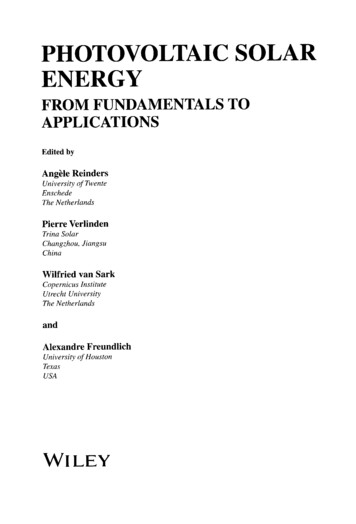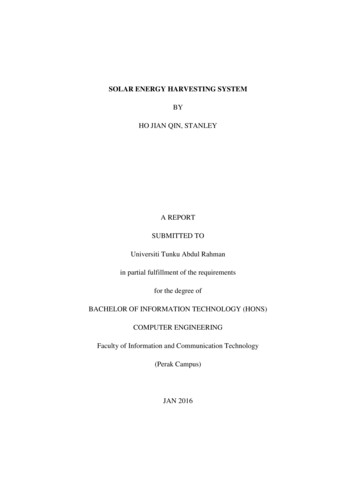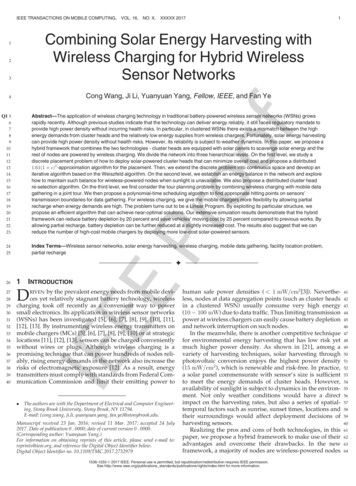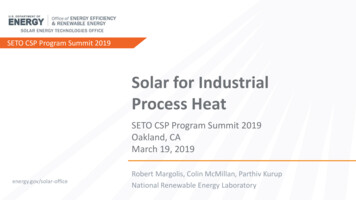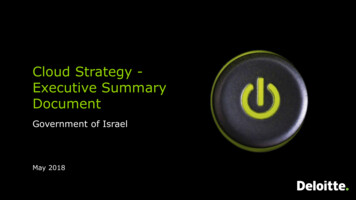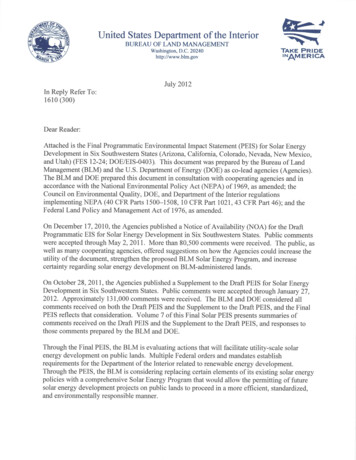
Transcription
FES 12-24 DOE/EIS-0403Final Programmatic Environmental Impact Statement (PEIS) forSolar Energy Development in Six Southwestern StatesExecutive Summary(Electronic copies of the Draft and Final Solar PEIS included)July 2012Bureau of Land ManagementU.S. Department of Energy
Final Programmatic Environmental Impact Statement (PEIS) for Solar Energy Development inSix Southwestern States (FES 12-24; DOE/EIS-0403)Responsible Agencies: The U.S. Department of the Interior (DOI) Bureau of Land Management (BLM)and the U.S. Department of Energy (DOE) are co-lead agencies. Nineteen cooperating agenciesparticipated in the preparation of this PEIS: U.S. Department of Defense; U.S. Bureau of Reclamation;U.S. Fish and Wildlife Service; U.S. National Park Service; U.S. Environmental Protection Agency,Region 9; U.S. Army Corps of Engineers, South Pacific Division; Arizona Game and Fish Department;California Energy Commission; California Public Utilities Commission; Nevada Department of Wildlife;N-4 Grazing Board, Nevada; Utah Public Lands Policy Coordination Office; Clark County, Nevada,including Clark County Department of Aviation; Doña Ana County, New Mexico; Esmeralda County,Nevada; Eureka County, Nevada; Lincoln County, Nevada; Nye County, Nevada; and Saguache County,Colorado.Locations: Arizona, California, Colorado, Nevada, New Mexico, and Utah.Contacts: For further information about this PEIS, contact: Shannon Stewart, BLM Washington Office,e-mail: shannon stewart@blm.gov, phone: (202) 912-7219; or Jane Summerson, DOE Solar PEISDocument Manager, e-mail: jane.summerson@ee.doe.gov, phone: (202) 287-6188; or visit the PEIS Website at http://solareis.anl.gov.Abstract: The BLM and DOE have jointly prepared this PEIS to evaluate actions that the agencies areconsidering taking to further facilitate utility-scale solar energy development in six southwestern states.1For the BLM, this includes the evaluation of a new Solar Energy Program applicable to solardevelopment on BLM-administered lands. For DOE, it includes the evaluation of developing newguidance to further facilitate utility-scale solar energy development and maximize the mitigation ofassociated potential environmental impacts. This Solar PEIS evaluates the potential environmental, social,and economic effects of the agencies’ proposed actions and alternatives in accordance with the NationalEnvironmental Policy Act (NEPA), the Council on Environmental Quality’s regulations for implementingNEPA (Title 40, Parts 1500–1508 of the Code of Federal Regulations [40 CFR Parts 1500–1508]), andapplicable BLM and DOE authorities.For the BLM, the Final Solar PEIS analyzes a no action alternative, under which solar energydevelopment would continue on BLM-administered lands in accordance with the terms and conditions ofthe BLM’s existing solar energy policies, and two action alternatives that involve implementing a newBLM Solar Energy Program that would allow the permitting of future solar energy development projectson public lands to proceed in a more efficient, standardized, and environmentally responsible manner.The proposed program would establish right-of-way authorization policies and design features applicableto all utility-scale solar energy development on BLM-administered lands. It would identify categories oflands to be excluded from utility-scale solar energy development and specific locations well suited forutility-scale production of solar energy where the BLM would prioritize development (i.e., solar energyzones or SEZs). The proposed action would also allow for responsible utility-scale solar development onlands outside of priority areas.1 Utility-scale facilities are defined as projects that generate electricity that is delivered into the electricitytransmission grid, generally with capacities greater than 20 megawatts (MW).
For DOE, the Final PEIS analyzes a no action alternative, under which DOE would continue to addressenvironmental concerns for DOE-supported solar projects on a case-by-case basis, and an actionalternative, under which DOE would adopt programmatic environmental guidance for use in DOEsupported solar projects.The BLM and DOE initiated the Solar PEIS process in May 2008. On December 17, 2010, the BLM andDOE published the Draft Solar PEIS. Subsequently, on October 28, 2011, the lead agencies published theSupplement to the Draft Solar PEIS, in which adjustments were made to elements of BLM’s proposedSolar Energy Program to better meet BLM’s solar energy objectives, and in which DOE’s proposedprogrammatic environmental guidance was presented.
SOLAR PEIS CONTENTSVOLUME 1Executive SummaryChapter 1:IntroductionChapter 2:Description of Alternatives and Reasonably Forseeable Development ScenarioChapter 3:Update to Overview of Solar Energy Power Production Technologies,Development, and RegulationChapter 4:Update to Affected EnvironmentChapter 5:Update to Impacts of Solar Energy Development and Potential MitigationMeasuresChapter 6:Analysis of BLM’s Solar Energy Development AlternativesChapter 7:Analysis of DOE’s AlternativesChapter 14: Update to Consultation and Coordination Undertaken to Support Preparation ofthe PEISChapter 15: List of PreparersChapter 16: GlossaryVOLUME 2Chapter 8:Chapter 9:Update to Affected Environment and Impact Assessment for Proposed SolarEnergy Zones in ArizonaUpdate to Affected Environment and Impact Assessment for Proposed SolarEnergy Zones in CaliforniaVOLUME 3Chapter 10:Update to Affected Environment and Impact Assessment for Proposed SolarEnergy Zones in ColoradoVOLUME 4Chapter 11:Update to Affected Environment and Impact Assessment for Proposed SolarEnergy Zones in NevadaVOLUME 5Chapter 12:Chapter 13:Update to Affected Environment and Impact Assessment for Proposed SolarEnergy Zones in New MexicoUpdate to Affected Environment and Impact Assessment for Proposed SolarEnergy Zones in Utah
SOLAR PEIS CONTENTS (Cont.)VOLUME 6Appendix A: Current and Proposed Bureau of Land Management Solar Energy DevelopmentPolicies and Design FeaturesAppendix B: Approved and Pending Solar ApplicationsAppendix C: Proposed BLM Land Use Plan Amendments under the BLM Action Alternativesof the Solar Energy Development Programmatic Environmental Impact StatementAppendix D: Update to Summary of Regional Initiatives and State Plans for Solar EnergyDevelopment and Transmission Development to Support Renewable EnergyDevelopmentAppendix E: Update to Methods for Estimating Reasonably Foreseeable DevelopmentScenarios for Solar Energy DevelopmentAppendix F: Update to Solar Energy Technology OverviewAppendix G: Update to Transmission Constraint AnalysisAppendix H: Update to Federal, State, and County Requirements Potentially Applicable toSolar Energy ProjectsAppendix I: Update to Ecoregions of the Six-State Study Area and Land Cover Types of theProposed Solar Energy ZonesAppendix J: Special Status Species Associated with BLM’s Alternatives in the Six-State StudyAreaAppendix K: Update to Government-to-Government and Cultural Resource ConsultationsAppendix L: Update to GIS Data Sources and MethodologyAppendix M: Update to Methodologies and Data Sources for the Analysis of Impacts of SolarEnergy Development on ResourcesAppendix N: Update to Viewshed Maps for Proposed Solar Energy ZonesAppendix O: Intermittent/Ephemeral Stream Evaluation and Groundwater Modeling AnalysesVOLUME 7Comments and Responses for the Programmatic Environmental Impact Statement for SolarEnergy Development in Six Southwestern States
031323334353637383940414243444546CONTENTSEXECUTIVE SUMMARY .ES-1ES.1 Background .ES.2 BLM Proposed Action .ES.2.1 BLM Purpose and Need.ES.2.2 BLM Scope of Analysis.ES.2.3 Applications for Solar Energy Development on BLM Lands .ES.2.4 BLM Alternatives .ES.2.4.1 Program Elements Common to Both BLMAction Alternatives .ES.2.4.2 Solar Energy Development Program Alternative(BLM Preferred Alternative) .ES.2.4.3 Solar Energy Zone Program Alternative .ES.2.4.4 No Action Alternative.ES.2.4.5 Reasonably Foreseeable Solar Energy Development .ES.2.4.6 Summary of Impacts of BLM’s Alternatives .ES.2.4.7 BLM’s Preferred Alternative .ES.3 DOE Proposed Action.ES.3.1 DOE Purpose and Need .ES.3.2 DOE Scope of Analysis .ES.3.3 DOE Alternatives.ES.3.3.1 Action Alternative (DOE Preferred Alternative) .ES.3.3.2 No Action Alternative.ES.3.4 Summary of Impacts of DOE’s Alternatives .ES.4 Public Involvement, Consultation, and Coordination .ES.5 References -45FIGURESES.2-1ES.2-2ES.2-3Areas Proposed for Exclusion Since Publication of the Supplementto the Draft Solar PEIS Based on Continued Consultation withCooperating Agencies and Tribes .ES-12BLM-Administered Lands in Arizona Available for Application forSolar Energy ROW Authorizations under the BLM AlternativesConsidered in This PEIS .ES-34BLM-Administered Lands in California Available for Applicationfor Solar Energy ROW Authorizations under the BLM AlternativesConsidered in This PEIS .ES-35Final Solar PEISES-iJuly 2012
0313233343536373839404142FIGURES (Cont.)ES.2-4ES.2-5ES.2-6ES.2-7BLM-Administered Lands in Colorado Available for Applicationfor Solar Energy ROW Authorizations under the BLM AlternativesConsidered in This PEIS .ES-36BLM-Administered Lands in Nevada Available for Application forSolar Energy ROW Authorizations under the BLM AlternativesConsidered in This PEIS .ES-37BLM-Administered Lands in New Mexico Available forApplication for Solar Energy ROW Authorizations under the BLMAlternatives Considered in This PEIS .ES-38BLM-Administered Lands in Utah Available for Application forSolar Energy ROW Authorizations under the BLM AlternativesConsidered in This PEIS .ES-39TABLESES.2-1Summary of Potentially Developable BLM-Administered Landunder the No Action Alternative, the Solar Energy DevelopmentProgram Alternative, and the SEZ Program Alternative .ES-5Exclusions under BLM’s Solar Energy Development ProgramAlternative.ES-8ES.2-3Proposed SEZs and Approximate Acreage by State .ES-13ES.2-4Reasonably Foreseeable Development Scenario: ProjectedMegawatts of Solar Power Development by 2030 andCorresponding Developed Acreage Estimates.ES-17Summary-Level Assessment of Potential Environmental Impactsof Utility-Scale Solar Energy Development by Alternative .ES-18Comparison of BLM’s Alternatives with Respect to Objectives forthe Agency’s Action .ES-30ES.2-2ES.2-5ES.2-6Final Solar PEISES-iiJuly 2012
031323334353637383940414243EXECUTIVE SUMMARYES.1 BACKGROUNDThe U.S. Department of the Interior (DOI) Bureau of Land Management (BLM) andU.S Department of Energy (DOE) have jointly prepared this programmatic environmental impactstatement (PEIS) to evaluate actions that the agencies are considering taking to further facilitateutility-scale solar energy development in six southwestern states (Arizona, California, Colorado,Nevada, New Mexico, and Utah).1 For the BLM, this includes the evaluation of a new SolarEnergy Program applicable to solar development on BLM-administered lands. For DOE, itincludes the evaluation of developing new guidance to further facilitate utility-scale solar energydevelopment and maximize the mitigation of associated environmental impacts. This Solar PEISevaluates the potential environmental, social, and economic effects of the agencies’ proposedactions and alternatives in accordance with the National Environmental Policy Act (NEPA) of1969, the Council on Environmental Quality’s regulations for implementing NEPA (Title 40,Parts 1500–1508 of the Code of Federal Regulations [40 CFR Parts 1500–1508]), the DOI andDOE regulations for implementing NEPA (43 CFR Part 46 and 10 CFR Part 1021, respectively),and applicable BLM and DOE authorities.The BLM and DOE initiated the Solar PEIS process in May 20
BLM Solar Energy Program that would allow the permitting of future solar energy development projects on public lands to proceed in a more efficient, standardized, and environmentally responsible manner. The proposed program would establish right-of-way authorization policies and design features applicable to all utility-scale solar energy development on BLM-administered lands. It would .


